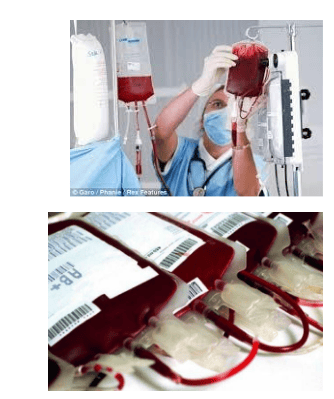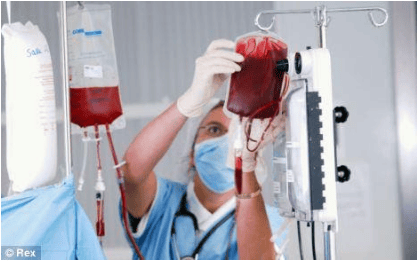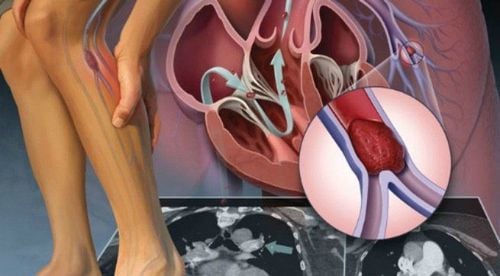This is an automatically translated article.
Posted by Specialist I Tran Thi Anh Hien - Anesthesiologist - Anesthesiology Department - Vinmec Central Park International General Hospital
Blood transfusion is the process of receiving blood or blood products into the circulatory system intravenously to replace lost blood components. However, in some cases, blood transfusion complications can still occur.
1. What is Mass Blood Transfusion?
Mass transfusion is the infusion of large volumes of blood over a short period of time in a patient with severe or uncontrolled bleeding.
In adults:
Transfuse a blood volume equivalent to the patient's blood volume within 24 hours or transfuse more than 10 units of erythrocyte sedimentation in 24 hours. Transfuse from 4 units of erythrocyte sedimentation over 1 hour and anticipate need for further transfusion. Replace more than 50% of patient's total blood volume in 3 hours In children:
Transfuse more than 100% of total blood volume in 24 hours. Supportive transfusion to replace continued blood loss of more than 10% of total total blood volume/min. Transfuse more than 50% of patient's whole blood volume over 3 hours The benefit of transfusion is to maintain perfusion and oxygenation to tissues. Massive blood transfusion also supports resuscitation in cases of severe hemorrhagic shock causing hypotension, emergency surgery to control damage, supportive treatment to avoid multi-organ failure.
Blood transfusion is a necessary issue to ensure the patient's life. However, in some cases, it can cause many dangerous blood transfusion complications, if not done correctly and controlled in time. Complications and complications of large-volume blood transfusion may occur such as: acute hemolysis due to blood group incompatibility, allergic-anaphylaxis, infection,...

2. Complications of large volume blood transfusion
During a large volume transfusion, potential risks that require major correction include:
2.1. Circulatory overload
The cause is due to the rapid infusion of a large volume of blood, causing circulatory overload, especially in the group of patients with pre-existing cardiopulmonary disease.
Prophylaxis:
Calculate a reasonable amount of blood to be transfused. Monitor urine flow and central venous pressure Adjust for CBC.
2.2 Blood clotting disorders
Causes:
Patient loses blood, reduces, lacks endogenous clotting factors, platelet deficiency. Coagulation factor deficiency occurs with large blood transfusions because the stored blood contains few clotting factors, especially factors V and VIII. Prophylaxis:
Basic coagulation tests: APTT, PT, Fibrinogen. ROTEM (Rotation Thrombo ElastoMetry) test is widely indicated in the case of massive blood transfusion to target therapy, correct coagulation factor deficiencies by: transamic hemostasis, fresh plasma, platelets, freezer
2.3. Acid-base disorder
The cause is due to prolonged blood loss causing a shortage of red blood cells to carry oxygen to tissues and organs, hypoxemia in the tissues, formation of anaerobic metabolism, and acidosis.
Prophylaxis:
Early correction of metabolic acidosis with Nabicarbonate. Detect thoracic lesions, combined lung, appropriate mechanical ventilation.
2.4. Body temperature disorder
Cause: Red blood cells are stored at 4 degrees C, platelets at 20-24 degrees C, fresh frozen plasma at -18 degrees C
Prophylaxis:
Warming blood by transfusion with saline temperature (39-43 degrees Celsius) to both warm and dilute the blood. Incubate the patient: hot air blower, silver blanket,...

2.5. Electrolyte disorder
Causes of electrolyte disturbances are:
Decrease in calcium due to side effects of anticoagulant Citrate. When a large volume of blood is transfused in a short time, calcium is highly bound to citrate, significantly reducing the amount of calcium ions in the blood. Signs of citrate toxicity are signs of hypocalcemia. Clinically severe hypocalcaemia causing cardiac depression: hypotension, weak pulse, end-diastolic pressure in the ventricles and increased central venous pressure. Hyperkalemia due to increased potassium in the blood after storage, the rupture of red blood cells, releasing potassium into the blood bag. Prophylaxis
Replace calcium chloride or calcium gluconate if hypocalcaemia occurs. In clinical practice, calcium chloride is often preferred because calcium gluconate must be metabolized by the liver first. Monitor potassium levels in large blood transfusions. Treatment of potassium deficiency if necessary To ensure safety, avoid complications caused by blood transfusion, must strictly follow the indications and principles of blood transfusion and closely monitor the patient during blood transfusion. Principles of selection of blood and blood products in mass transfusion:
Ensure optimal ABO and Rh blood group matching between donors and recipients, and perform matching tests on each unit of blood transfused. In case there is no blood group, it is possible to use group O blood with low antibody titres, also known as non-dangerous O blood for transfusion to patients with blood groups A and B; or use group A blood or group B blood for transfusion for patients with blood group AB or group O red blood cells for transfusion for patients with blood group A, B, AB. If whole blood of different types has been used to transfuse the patient and there is no group of O red blood cells, all efforts must be made to ensure that blood group during the emergency period for the patient. Transfused blood must be maintained at 37°C by means of blood warmers. Blood used in bulk transfusion should be stored within 72 hours or no more than 5 days preferably. Mass transfusion is the infusion of large volumes of blood over a short period of time in a patient with severe or uncontrolled bleeding. To avoid complications during blood transfusion, patients should choose reputable medical facilities for implementation.
Vinmec International General Hospital has implemented the regulation of blood transfusion in the emergency and treatment of obstetric diseases, surgery, emergency trauma,... Accordingly, the use of blood and preparations from blood follow a standard, closed and strict process to ensure maximum safety for blood recipients. In particular, the procedures for receiving, storing and assigning blood transfusions are well-trained and operated by a team of highly skilled doctors and nurses on modern machinery to provide optimal treatment results. for your customers.
Please dial HOTLINE for more information or register for an appointment HERE. Download MyVinmec app to make appointments faster and to manage your bookings easily.














